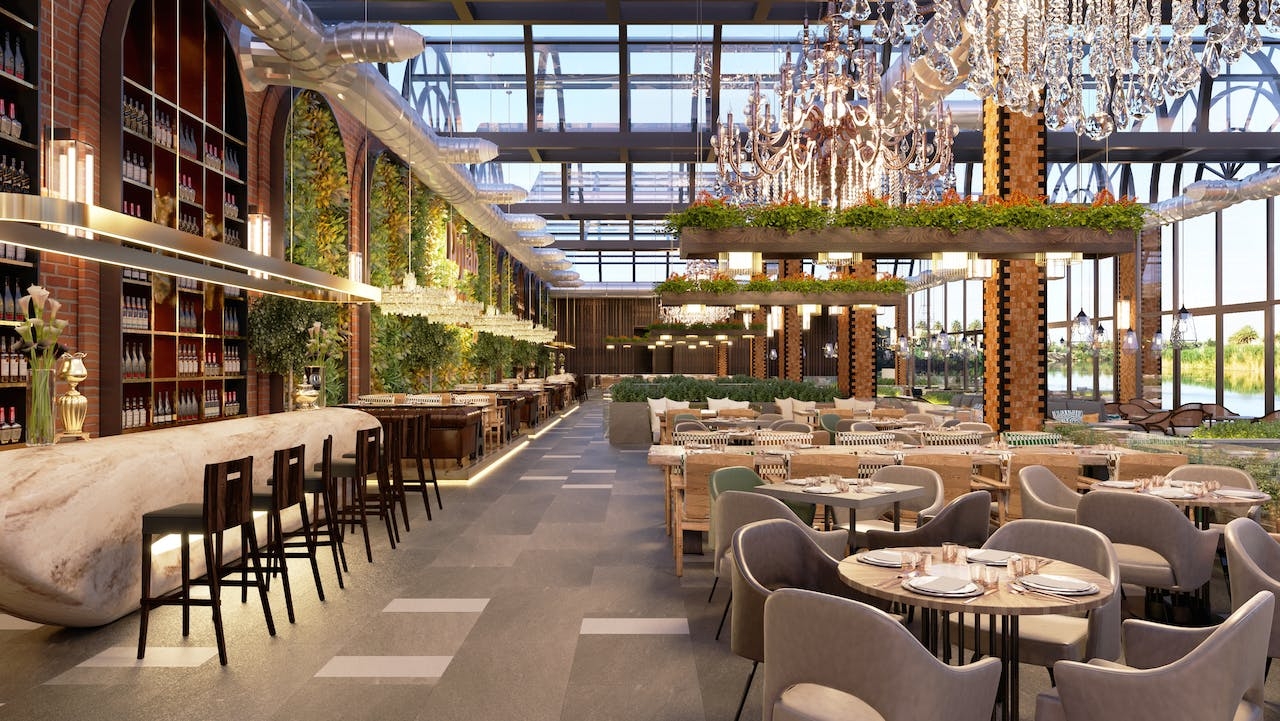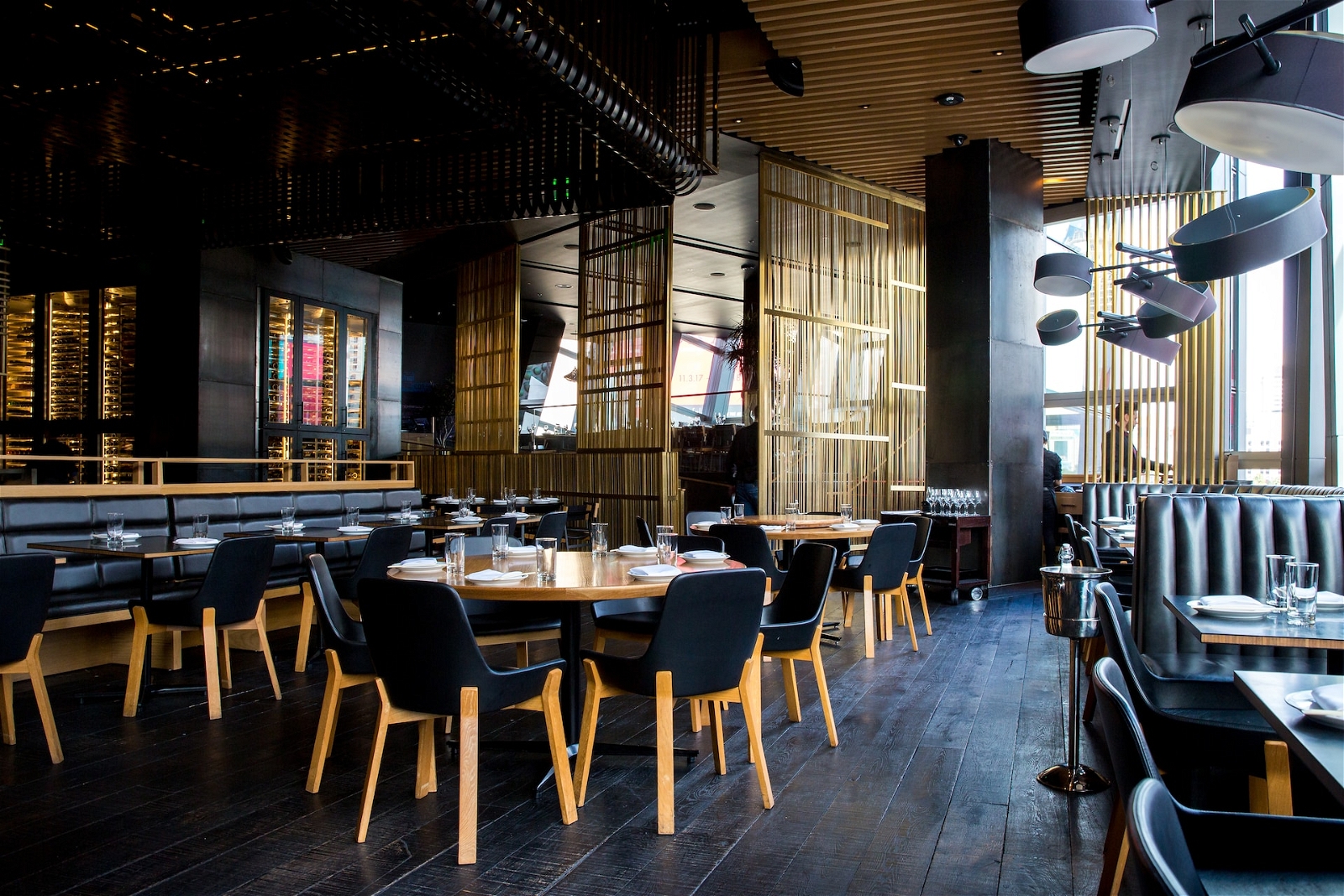Exploring Restaurant Concepts: Defining Your Dining Experience
By Nikita Nielsen · 1. March 2024
What is a restaurant concept? A restaurant concept is more than an overarching theme—it’s a strategic blueprint that consistently shapes a restaurant’s menu, ambiance, and service to create a unique dining experience.
It’s what frames your expectations before you walk in and what lingers after you leave.
In this article, we peel back the layers of what a restaurant concept is, uncovering the essentials of creating a compelling culinary identity and standing out in a crowded food landscape.
Key Takeaways
- A restaurant concept is the core identity of a dining establishment that combines theme, ambiance, and menu to create a distinctive dining experience, which is pivotal for attracting and retaining customers.
- The restaurant industry offers a diverse array of concepts ranging from fine dining and casual restaurants to fast food and fast casual, each catering to specific customer demands and dining preferences.
- Restaurants are navigating challenges such as economic pressures and changing consumer preferences by embracing sustainability, adapting their offerings, and leveraging technology to streamline operations and improve efficiency.
Understanding Restaurant Concepts
 Restaurant Concept
Restaurant Concept
The concept of a restaurant serves as the soul and blueprint of a dining establishment, dictating its identity through the food it serves and the ambiance it provides. It acts as the heartbeat, merging every aspect to form a unique dining narrative.
This is not just about what’s on the plate; it’s about creating a world that customers step into, a world that stands out in the bustling marketplace of dining options.
The success🏆 of a restaurant hinges on this concept, as it’s the magnet that draws in customers, earns rave reviews, and builds a base of loyal guests.
In the fiercely competitive culinary world, a clear and consistent restaurant concept sets the foundation for uniqueness.
It’s what makes a restaurant more than just a place to eat; it’s what turns it into a destination. By intertwining theme, ambiance, and menu, a successful restaurant concept becomes a story that diners want to tell and retell.
Consider the glow of a fine dining restaurant’s chandeliers, the buzz of a casual bistro, or the efficiency of a fast food joint. Each presents a distinct dining room atmosphere, a unique menu, and a targeted service style that speaks to a particular customer base.
Theme and Atmosphere
The power of a restaurant’s theme and overall concept lies in its ability to evoke emotions and transport diners to a different place or time.
Imagine stepping into a venue where the luxurious decor and expertly crafted cocktails whisk you away to an era of elegance and sophistication.
This transformative experience is crafted through careful selection of colors, lighting, and furnishings, all of which influence the mood and behavior of customers, encouraging them to linger, indulge, and return.
The atmosphere also dictates how guests interact with one another. A serene setting with soft music may foster intimate conversations, while a lively, vibrant space might be the perfect backdrop for group gatherings and socializing.
It’s this ambiance that can create a sense of belonging and community, making the dining experience memorable and shareable.
Target Market
Pinpointing a restaurant’s target market is akin to discovering a treasure chest key; it uncovers opportunities to cater specifically to the group’s desires and needs.
Whether it’s the bustling business lunch crowd in a downtown district or families searching for a weekend treat in a suburban neighborhood, the chosen location of a restaurant can significantly influence its target market.
Understanding these demographics, along with customer behavior and preferences, is pivotal for a restaurant’s business plan and attracting customers who resonate with the overall concept.
The significance of aligning the restaurant’s offerings with the target market is paramount. It is the compass that guides menu development, marketing efforts, and service styles.
It helps create a complete guide for reaching the right audience, ensuring that the story being told within the restaurant’s walls echoes in the hearts of those who dine there.
Menu and Cuisine
At its foundation, a restaurant concept extends beyond just food; it encompasses the narratives conveyed by the dishes and the cultures they signify.
From the Mexican-Cali cuisine that chef Ramon ‘El Tigre’ Ramos brings to life in his pop-ups to the meat-free offerings at Bubala in London, menus are a direct reflection of a restaurant’s identity and culinary narrative.
A well-structured menu that aligns with the dining experience and restaurant’s theme can significantly enhance customer satisfaction.
Some key considerations for creating a successful menu include:
- Leveraging the farm-to-table movement to emphasize freshness and sustainability🌱
- Embracing menu development that resonates with local tastes and preferences
- Pricing models that are competitive and appealing to customers
- Offering a variety of options to cater to different dietary restrictions and preferences
By carefully considering these factors in your restaurant business plan, you can create a menu that enhances your restaurant concept’s success and delights your customers.
Moreover, menu updates that reflect changing customer preferences keep the dining experience fresh and relevant.
Popular Restaurant Concept Types
 restaurant interior
restaurant interior
From the indulgent opulence of fine dining restaurants to the energetic hustle of quick service restaurants, the variety of restaurant concepts is as diverse as the palates they cater to.
Each concept type offers a distinct dining experience, designed to meet the expectations of different customer segments.
Some examples of restaurant concepts include:
- Fine dining establishments, which are synonymous with elegance and exclusivity
- Casual restaurants, which offer a laid-back atmosphere with a wide range of menu items
- Fast food restaurants, which are built for speed and convenience, serving up meals that are quick and easy to enjoy on the go
The landscape of dining options is rich and varied, including:
- Food trucks with their eclectic and often gourmet street fare
- Cafes where conversations flow as smoothly as the coffee served
- Full-service restaurants that promise a more traditional dining experience
Each restaurant concept carries its own allure and customer attraction strategy, be it via ambiance, menu offerings, or an innovative concept that sparks the imagination.
Fine Dining
Fine dining is the epitome of culinary sophistication, where every detail, from the crispness of the table linen to the precision of the service style, is meticulously crafted.
These establishments are temples to gastronomy, where chefs become artists and meals become masterpieces. Guests are not just dining; they are partaking in an event, an experience that often calls for a dress code and a willingness to savor each bite in an unhurried fashion.
The allure of fine dining restaurants lies in their promise to offer more than just food; they offer a journey through flavors and textures, presented with an artistry that commands a higher price point and caters to special occasions.
With various fine dining concepts to choose from, each restaurant creates a unique experience for its guests, showcasing what fine dining restaurants offer.
The ambiance of a fine dining restaurant is a critical component of the dining experience. Here are some key elements that contribute to the ambiance:
- Elegant interior design, often with luxurious touches
- A serene atmosphere that sets the stage for a memorable meal
- Fine dining menus that may feature a prix fixe selection, allowing the chef to showcase their skill through a curated sequence of dishes
- A la carte options that give diners the freedom to create their own culinary adventure
These elements come together to create a truly exceptional dining experience.
Casual Dining
Casual dining strikes a balance between the formality of fine dining and the quick convenience of fast food. It’s the go-to choice for diners looking for a full-service experience that’s easy-going and wallet-friendly.
These family style restaurants are versatile, capable of setting the scene for a variety of occasions, from family outings to dinner with friends.
Themed and interactive dining experiences are hallmarks of the casual dining segment. Themes can transport diners to different eras or cultures, while interactive dining allows guests to be part of the action, such as fishing for their dinner at Zauo in Tokyo.
Casual dining showcases an impressive versatility and inventiveness, particularly noticeable in London’s pop-up dining scenes like “The Secret Garden,” which transform a simple meal into an extraordinary urban escapade, complete with lush greenery and a sense of enchantment.
Fast Food and Fast Casual
 fast food joint
fast food joint
Fast food and fast casual are the dynamos of the dining world, catering to the ever-increasing pace of modern life. Fast food restaurants, with their streamlined service and standardized menus, epitomize convenience.
They are the quintessential choice for those who need a quick bite without the frills of table service. On the other hand, fast casual restaurants offer a hybrid experience, blending the ease of fast food🍔 with the quality and atmosphere of casual dining.
Millennials, in particular, are drawn to fast casual establishments for their upscale food, environmentally conscious ethos, and inviting sit-down atmosphere.
Brands like Chipotle and Shake Shack have set the bar high, offering customizable meals, fresh salads, and gourmet burgers that rise above the typical fast food fare.
These concepts are redefining what it means to dine quickly without compromising on quality or experience.
Developing Your Unique Restaurant Concept
 restaurant chefs
restaurant chefs
Developing an unforgettable restaurant concept involves weaving together a compelling narrative, drawing upon personal inspiration, and understanding the subtleties of the target market.
The journey of developing a unique concept is not just about creating a menu or choosing decor; it’s about crafting a story that resonates with diners and stands out in the competitive landscape of the restaurant industry.
A successful restaurant concept is built on a clear vision and mission, a strategic understanding of market positioning, and a consistent brand voice that echoes across all touchpoints, from the menu to the marketing channels.
Personal passion and expertise serve as the secret ingredients, instilling authenticity into a restaurant’s story.
They drive the creative process and inspire the kitchen staff, front-of-house team, and ultimately, the customers.
The choice of location and competitive analysis are also crucial in shaping a restaurant’s concept, ensuring its relevance and appeal to the local customer base.
From the use of management tools to streamline operations to the careful calibration of operational strategies, every detail contributes to the success of the restaurant’s concept.
Passion and Expertise
The heart of a restaurant’s narrative beats with the passion and expertise of its creators. It’s this authenticity that captivates customers and creates an engaging experience.
Passion is the emotional fuel that drives restaurant owners to pursue excellence and deliver a dining experience that’s both successful and meaningful.
The inspiration derived from personal experiences, styles, and culinary traditions infuses the restaurant with a soul that customers can sense and appreciate.
Achieving a state of flow in the restaurant where everything operates in harmony is essential.
This state is reached when the owner’s vision aligns with the skills and dedication of the chefs and kitchen staff, resulting in a dining experience that is seamless, enjoyable, and memorable for all involved.
Branding and Marketing
A distinct brand voice and cohesive visual branding are essential for communicating the restaurant’s character and unique identity.
From the mood board to the brand book, every visual element must be carefully chosen to express the restaurant’s personality and resonate with the target market.
Interior design is not just about aesthetics; it’s an integral part of the brand story, connecting with customers on multiple sensory levels.
The digital age has transformed how restaurants interact with their customers. Utilizing marketing channels like social media, advertising, and word-of-mouth is crucial for promoting the restaurant concept and engaging with the audience.
Understanding customer behavior, including dining frequency and digital activity, aligns marketing strategies with service offerings, creating a seamless connection between the restaurant and its customers.
Successful Restaurant Concept Examples
 #image_title
#image_title
The restaurant industry is rife with successful restaurant concepts that illustrate the power of a well-executed idea. Here are some examples:
- Saved By The Max – taps into nostalgia with its pop culture theme
- Undersea Restaurant at Hurawalhi – immerses diners in an underwater dining adventure
- Dinner in the Sky – elevates the dining experience to literal new heights, combining the thrill of height with gourmet cuisine
- At.mosphere in Dubai – offers luxury dining on the 122nd floor, providing breathtaking views and an unparalleled dining atmosphere
These concepts offer unforgettable experiences that captivate and inspire.
The success of these concepts is not just in their novelty; it’s in their ability to resonate with diners on a deep level.
Adapting to Consumer Preferences
In a world characterized by ever-changing consumer preferences, it’s crucial for restaurants to remain adaptable and responsive.
Healthier eating options, accommodations for dietary restrictions, and a preference for locally-sourced ingredients represent the changing currents of consumer demand.
Fast-casual chains are riding the wave of success by offering menus that cater to a variety of dietary needs, from vegan to gluten-free.
This adaptability is not just a passing trend; it is a strategic business move, with 38% of consumers indicating they’re more likely to choose restaurants that feature locally-sourced foods, pointing to a broader desire to support local businesses and sustainable practices.
The appetite for alternative proteins and meat substitutes is also on the rise, driven by concerns over the environmental footprint of traditional meat production.
Restaurants that pivot to embrace these preferences are not just catering to health and environmentally-conscious consumers but are also positioning themselves at the forefront of a significant industry shift, proving that they offer not just food, but a sustainable dining experience.
Embracing Sustainability
The demand for sustainability in the restaurant industry is escalating, with diners increasingly seeking establishments that mirror their values.
Restaurants are responding by integrating sustainable practices into their sourcing and operations.
Smashburger’s commitment to antibiotic-free ingredients, Pret A Manger’s focus on organic coffee and natural foods, and Jamie’s Italian championing of farm-to-fork dining are all shining examples of how sustainability can be woven into the fabric of a restaurant’s concept.
Beyond sourcing, restaurants are also revolutionizing their approach to packaging, turning away from single-use plastics in favor of biodegradable♻️ or refillable options, thereby reducing their environmental footprint.
Waste reduction is another frontier in the sustainability crusade. Through strategic waste management and efficient supply chain systems, restaurants are finding ways to minimize food waste and partner with organizations that repurpose what can’t be avoided.
By improving inventory management and order accuracy, restaurants can significantly cut down on waste, contributing to a more sustainable operation.
Furthermore, educating both staff and guests about sustainability initiatives has several benefits:
- Fosters a culture of environmental responsibility
- Enhances the restaurant’s brand reputation
- Attracts customers who value and are willing to pay more for sustainable dining experiences.
Leveraging Technology
In the digital era, technology functions both as a lifeline and a driving force for the restaurant industry.
By embracing innovations such as self-service techs, contactless processes, and data-driven tools, restaurants can not only improve efficiency but also offer secure and personalized dining experiences.
Online order management systems and digital loyalty programs are becoming the norm, streamlining the ordering and payment process for guests and businesses alike.
The proliferation of technology in restaurant kitchens is transforming the industry in several ways:
- AI and smart kitchen technologies are simplifying tasks and offering solutions to labor shortages, while ensuring consistency and speed.
- Robotic equipment is automating repetitive tasks, such as food preparation and dishwashing.
- Dynamic pricing strategies are allowing restaurants to adjust their offerings based on demand, maximizing revenue.
- Virtual brand marketplaces are emerging, allowing restaurants to make better use of their kitchen space and expand their offerings.
These advancements are helping restaurants adapt to economic challenges and evolving consumer behaviors, ensuring they remain competitive in a market that never stands still.
Summary
The world of restaurant concepts reveals a rich tapestry of themes, flavors, and experiences that define the restaurant industry.
From the elegance of fine dining to the convenience of fast casual, each concept caters to a unique set of customer preferences and expectations.
The challenges facing restaurant owners are significant, but so are the opportunities to innovate, adapt, and thrive.
By embracing change, focusing on sustainability, and leveraging technology, restaurants can craft experiences that resonate with diners today and tomorrow.
Let this exploration be a source of inspiration, whether you’re a restaurateur or a diner, to appreciate the narratives behind every meal and the concepts that make them unforgettable!
Frequently Asked Questions
What is the focus of a restaurant concept?
The focus of a restaurant concept is to shape its identity, design, menu, culture, and overall experience, distinguishing it from others in the industry.
What is a concept statement for a restaurant?
A restaurant concept statement outlines the identity, design, menu, culture, and overall experience of the restaurant, setting it apart from others in the industry.
Why is the restaurant concept important?
The restaurant concept is important because it forms the foundation of your brand and influences how customers perceive and experience your restaurant, as well as how you will run and operate your business.
What are some popular types of restaurant concepts?
Some popular types of restaurant concepts include fine dining, casual dining, fast food, fast casual, pubs and bars, cafes, and food trucks. Each type offers a unique dining experience tailored to specific customer preferences.

